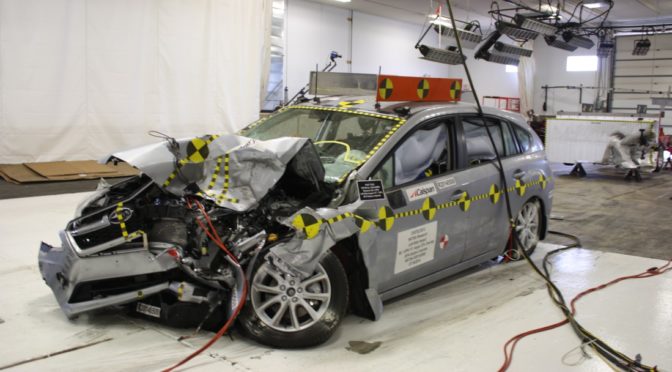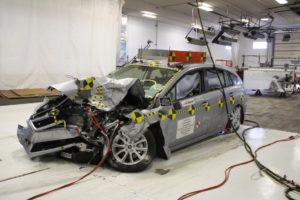
If you drive a Subaru, there’s a good chance you do so because you learned about their reputation for safety, whether from direct advertising or from word of mouth from friends and family. It’s not hard to see why Subaru has largely replaced Volvo in the minds of many families when it comes to associations with safety; the Outback, Legacy, and Forester are frequent members on the IIHS’ “top safety pick” lists each year, regardless of which additional standards the IIHS tacks on (most recently, the passenger-side small overlap test).
However, safety has far more to do with how vehicles actually stand up to our blood-soaked highways than it does with controlled crash tests. If you really want to know how many people die driving particular vehicles, you can pull FARS data directly from the NHTSA and analyze it yourself. However, if you’d rather get a summary of their results and are willing to surrender some accuracy, you can check the IIHS’ calculations instead. They have a.) large error margins and b.) neglect two thirds of what matters most in auto safety–road design and driver behavior–but the numbers are still interesting to review.
This is part of an ongoing series I’ve written reviewing data from the IIHS’ summer 2017 Status Report (volume 52, number 3); previous articles include comparisons between the Outback, Forester, and Legacy, the Accord and Camry, the Sienna and Odyssey, the Cruze and Suburban, and the CRV and Pilot. Today we’ll look at whether or not there’s a safety difference between the Subaru Outback and its smaller hatchback siblings, the Subaru Impreza and Crosstrek, which itself is just a raised version of the Impreza wagon.
2011-2014 Subaru Outback – 12 driver deaths (5-20)
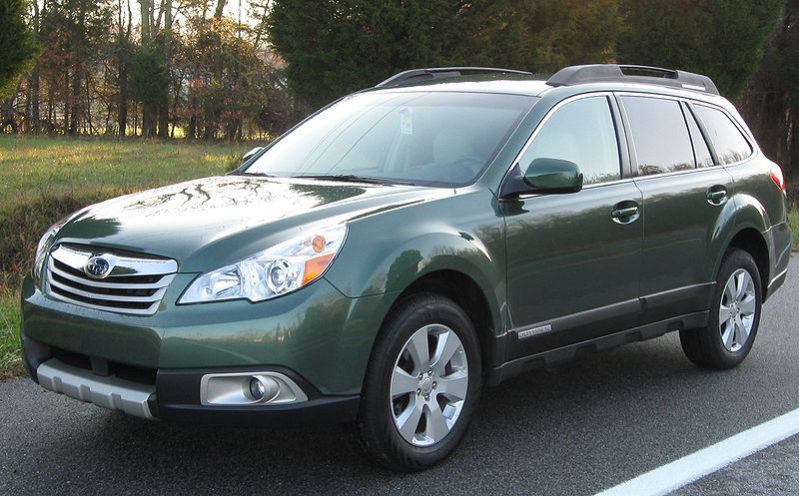 According to the IIHS, the Subaru Outback had an estimated driver death rate of 12 during the 2011-14 model years, with 8 of those deaths predicted to occur from multiple vehicle crashes. The exposure was based on 1,116,891 registered vehicle yeas, resulting in a confidence bound of 5-20. In plain English, this means that the IIHS estimates that if 1 million drivers drove 1 million Outbacks of the aforementioned model years throughout the United States, we’d expect 12 of them to die over the course of a year, and would expect the actual death figure to be between 5 and 20 95% of the years measured.
According to the IIHS, the Subaru Outback had an estimated driver death rate of 12 during the 2011-14 model years, with 8 of those deaths predicted to occur from multiple vehicle crashes. The exposure was based on 1,116,891 registered vehicle yeas, resulting in a confidence bound of 5-20. In plain English, this means that the IIHS estimates that if 1 million drivers drove 1 million Outbacks of the aforementioned model years throughout the United States, we’d expect 12 of them to die over the course of a year, and would expect the actual death figure to be between 5 and 20 95% of the years measured.
2012-2014 Subaru Impreza 4WD Hatchback – 12 driver deaths (3-36)
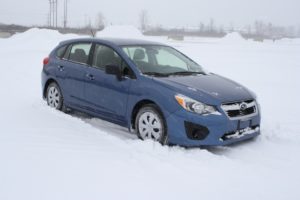 The Impreza hatchback (not sedan) also had an estimated driver death rate of 12 during the 2012-14 model year, with 8 of those deaths again predicted to occur in multi-vehicle crashes. The exposure was based on 245,970 registered vehicle years, a figure roughly 1/5th the size of the Outback’s, resulting in a much larger confidence bound (it spanned 34 instead of 16 as with the Outback). As with the Outback’s driver death rate, we need to remember that the number doesn’t mean 12 drivers died while driving Imprezas; it means that if we looked at 500,000 drivers behind the wheel of 500,000 2012-14 Impreza hatchbacks over 2 years (or 1 million over 1 year), we’d expect 12 to die over that time period.
The Impreza hatchback (not sedan) also had an estimated driver death rate of 12 during the 2012-14 model year, with 8 of those deaths again predicted to occur in multi-vehicle crashes. The exposure was based on 245,970 registered vehicle years, a figure roughly 1/5th the size of the Outback’s, resulting in a much larger confidence bound (it spanned 34 instead of 16 as with the Outback). As with the Outback’s driver death rate, we need to remember that the number doesn’t mean 12 drivers died while driving Imprezas; it means that if we looked at 500,000 drivers behind the wheel of 500,000 2012-14 Impreza hatchbacks over 2 years (or 1 million over 1 year), we’d expect 12 to die over that time period.
2013-2014 Subaru XV Crosstrek 4WD – 17 driver deaths (4-51)
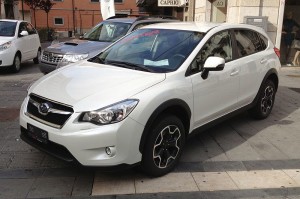 Finally, let’s look at the XV Crosstrek. It had the greatest estimated rate of driver deaths at 17 for the 2013-14 model years, with 6 predicted multiple vehicle fatalities. The exposure was based on 173,380 registered vehicle years, the smallest of the three wagons. As a result, it had the largest confidence bound at 48 instead of 34 as with the Impreza hatchback or 16 as with the Outback. As a reminder, the IIHS won’t include any vehicle in their calculations with fewer than 100,000 registered vehicle years, and a registered vehicle year is one vehicle registered for a full year. Below 100,000, the IIHS either feels the model shows too much error or too large of a confidence bound for them to be taken seriously. At any rate, the driver death figure again suggests that if 1 million drivers drove 1 million 2013-14 Crosstreks for a year throughout the US, we’d expect 17 of them to die.
Finally, let’s look at the XV Crosstrek. It had the greatest estimated rate of driver deaths at 17 for the 2013-14 model years, with 6 predicted multiple vehicle fatalities. The exposure was based on 173,380 registered vehicle years, the smallest of the three wagons. As a result, it had the largest confidence bound at 48 instead of 34 as with the Impreza hatchback or 16 as with the Outback. As a reminder, the IIHS won’t include any vehicle in their calculations with fewer than 100,000 registered vehicle years, and a registered vehicle year is one vehicle registered for a full year. Below 100,000, the IIHS either feels the model shows too much error or too large of a confidence bound for them to be taken seriously. At any rate, the driver death figure again suggests that if 1 million drivers drove 1 million 2013-14 Crosstreks for a year throughout the US, we’d expect 17 of them to die.
Does this mean the Outback and Impreza is the safest, followed by the Crosstrek?
Not at all. Although the Outback and Impreza had the lowest driver death rates at 12, followed by the Crosstrek at 17, the driver death rates of all three vehicles were statistically the same. This is why it’s important to read and understand the confidence bounds. The 95% confidence bounds suggest where we’d find the true driver death rate 95% of the time we let drivers and vehicles loose (e.g., when 1 million drivers drove 1 million vehicles for a year, or when 500,000 drivers drove 500,000 vehicles for 2 years, and so on). I tend to use 1 million as the sample when explaining this because the IIHS bases their driver death rate figures on 1 million registered vehicle years, but you could technically use any sample as long as it added up to the same amount of vehicles, drivers, and time on the road.
Per the model, the Outback’s true driver death rate would almost always fall between 5 and 20. The Impreza’s would land between 3 and 36, and the Crosstrek’s between 4 and 51. In other words, there’s a chance (5-20, or 16, out of 3-51, or 49) of 16/49, or 33%, that all three vehicles have exactly the same driver death rate. It’s possible the Outback had the lowest true driver death rate. It’s also possible that the Impreza or Crosstrek would see the fewest driver deaths. The point is that you can’t say which of the vehicles is definitely safer based on the numbers, despite the fact that hundreds of thousands of them were driven across the country in all kinds of conditions for years. Or to be blunt, there’s no way to prove that any differences in how many drivers lived or died aren’t simply due to chance.
How can the Impreza, Crosstrek, and Outback be equally safe if the Outback is bigger–i.e., longer, wider, and heavier?
 The reason the Outback, Impreza, and Crosstrek are equally safe vehicles in real world driving despite the size differences is because staying alive as a driver (or passenger) has much more to do with driver behavior and road safety than it does with vehicle selection once a vehicle has basic safety safety features in place. It’s the same reason why a Prius is as safe as vehicles weighing two or three times as much, why a CR-V is as safe as a Pilot, and why a Cruze is as safe as a Suburban. And don’t forget that next to semi-trucks, buses, and garbage trucks, we’re all driving tiny, featherweight vehicles.It doesn’t matter whether you’re in a 3,000 pound (e.g., an Impreza), 3,500 pound (e.g., an Outback), or 5,000 pound (e.g., a Ford F-150) vehicle when a second away from a head-on collision with a 60,000 pound truck. Focus on avoiding the truck, not on trusting your car to see you through the crash.
The reason the Outback, Impreza, and Crosstrek are equally safe vehicles in real world driving despite the size differences is because staying alive as a driver (or passenger) has much more to do with driver behavior and road safety than it does with vehicle selection once a vehicle has basic safety safety features in place. It’s the same reason why a Prius is as safe as vehicles weighing two or three times as much, why a CR-V is as safe as a Pilot, and why a Cruze is as safe as a Suburban. And don’t forget that next to semi-trucks, buses, and garbage trucks, we’re all driving tiny, featherweight vehicles.It doesn’t matter whether you’re in a 3,000 pound (e.g., an Impreza), 3,500 pound (e.g., an Outback), or 5,000 pound (e.g., a Ford F-150) vehicle when a second away from a head-on collision with a 60,000 pound truck. Focus on avoiding the truck, not on trusting your car to see you through the crash.
Does this mean that my loved ones are equally safe in an Impreza, Crosstrek, and Outback?
Yes. If you want to keep your husband, wife, children, or family safe, any of the three vehicles above will be more than enough to check the “good enough” box for vehicle selection. The lion’s share of what makes the difference will be tied to the degree to which you choose safe speeds, follow best practices with car seats, and choose safe roads. These factors will make far more of a difference in avoiding and surviving crashes than the vehicle you choose.
 If you find my information on best practices in car and car seat safety helpful, you can buy my books here or do your shopping through this Amazon link. Canadians can shop here for Canadian purchases. Have a question or want to discuss best practices? Send me an email at carcrashdetective [at] gmail [dot] com.
If you find my information on best practices in car and car seat safety helpful, you can buy my books here or do your shopping through this Amazon link. Canadians can shop here for Canadian purchases. Have a question or want to discuss best practices? Send me an email at carcrashdetective [at] gmail [dot] com.

